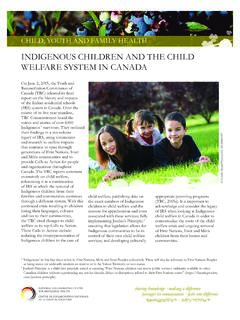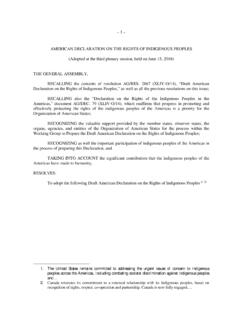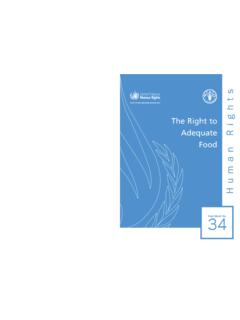Transcription of Indigenous experiences with racism and its impacts - NCCIH
1 Definition of terms racism is a belief or behaviour based on the notion that race is the basis of human characteristics and practices, and that racial differences produce inherent superiorities or inferiorities in particular races (Merriam-Webster Dictionary, 2013a).Racialize refers to the practice of assigning a racial identity to a person or group of people (Merriam-Webster Dictionary, 2013b). Credit: Fred Cattroll, knowledge making a difference partager les connaissances faire une diff rence 1 The terms Indigenous and Indigenous peoples are used throughout this fact sheet to refer to First nations , Inuit and M tis peoples inclusively; however, the terms Aboriginal and Aboriginal peoples will be used as substitutes when reflected in the literature under discussion. Whenever possible, culturally specific names are DETERMINANTS OF HEALTHINDIGENOUS experiences WITH racism AND ITS IMPACTSP repared by Samantha Loppie, Charlotte Reading & Sarah de LeeuwThis fact sheet is the second in a series focused on anti- Indigenous racism in Canada.
2 The first fact sheet examined the concept of race and racism , exploring the various forms it takes. In this fact sheet, the focus is on the lived and structural forms of racism . We begin by providing a brief overview of what racism is, how it intersects with other forms of discrimination, and how it is manifested. The fact sheet then moves to a discussion of how the dominant racialized group ( , European settlers) expresses racism in historic and current contexts and how Indigenous 1 people in Canada experience is experienced by Indigenous peoples and how it impacts their in interpersonal, structural and sometimes violent ways. We examine racism within government policies, healthcare, and judicial systems, and explore the unique ways that racism 2 IntroductionRacism is a social injustice based on falsely constructed, but deeply embedded, assumptions about people and their relative social value; it is often used to justify disparities in the distribution of resources (MacKinnon, 2004).
3 racism manifests in multiple ways that allow some groups of people to see themselves as superior to others and to claim and maintain multiple forms of political, sociocultural, and economic power. racism also intersects with, as well as reinforces, other ways in which human beings discriminate against each other, including socially constructed categories of gender, disability, ability, sexual orientation, class, and age (Heldke & O Connor, 2004). racism must be understood as something that is lived; it is experienced by individuals, families, communities, and nations through interactions and structures of the everyday world. The truth is that the ideologies, social prejudices and words upon which race and racism are built do a great deal of damage. In fact, racism infects the lives of individuals and institutions - sometimes quietly, sometimes covertly, sometimes immediately, and sometimes over long periods of time, but always unjustly.
4 racism is an experience acutely felt by many Indigenous people in Canada. For example, according to a 2005 report of the First nations Regional Longitudinal Health Survey (RHS), 38% of participating First nations adults experienced at least one instance of racism in the past 12 months; 63% of them felt that it had at least some effect on their self-esteem (First nations Centre, 2005). Expressions of racismThe labeling of individuals and groups as different is part of the process of creating social hierarchies, which represents the foundation of oppression (de Leeuw, Kobayashi, & Cameron, 2 011). Throughout most human societies, particular groups have consistently been othered , marginalized and discriminated against (de Leeuw, Kobayashi, & Cameron, 2 011). The renowned theorist Foucault proposed that discrimination is not always expressed in violent ways ( , slavery, genocide) but can take less aggressive forms ( , colonialism) that present power inequalities as neutral and natural processes (de Leeuw, Kobayashi, & Cameron, 2 011).
5 Yet all forms of oppression, including racism , contribute negatively to the well-being of certain racialized groups (Clark, Anderson, Clark, & Williams, 1999). Within the racialized hierarchy of Canadian society, Indigenous peoples continue to be othered by settler 2 groups in an attempt to rationalize colonial actions that disadvantage, oppress, and ultimately harm them (de Leeuw, Kobayashi, & Cameron, 2 011). Within Canada, anti- Indigenous racism is expressed in numerous ways: through stereotyping, stigmatization and violence, as well as through many of the structures of Canadian stereotypes and stigmaThere are a number of negative stereotypes associated with Indigenous people , including assumptions about the pervasiveness and cause of alcohol and drug addiction, unemployment, and violence (Backhouse, 1999; de Leeuw, Kobayashi, & Cameron, 2 011). One persistent and particularly damaging depiction is that Indigenous peoples are willing wards of the state, dependent on others and ultimately better off when the federal government oversees their affairs (Erickson, 2005).
6 This not only degrades the autonomy of Indigenous peoples and their legitimate right to be self-determining, but it has damaged the self-concept of countless generations of people who unfortunately, at times, internalize such demeaning stereotypes (Harding, 2006). 2 A settler is defined as a person who settles in an area [such as the European settlers of North America] (Oxford Dictionaries, ). Credit: , ID 28812119. Idle No More Widespread backlash against the Idle No More movement demonstrates the unfortunate but undeniable anti- Indigenous racism that persists within Canada (Perkel, 2013, Van Bemmel, 2013). The Idle No More (INM) movement began when four Indigenous women in Saskatoon, Saskatchewan responded to the Canadian Parliament adopting the Omnibus Bill C-45, which included a number of unfair amendments to Aboriginal land rights (Gordon, 2013). The bill would offer deregulation for industrial development and allow companies to buy and sell reserve land without consideration or compensation to the communities on those lands (Paradis, 2013).
7 This bill disregarded Aboriginal land rights and ignored the environmental and health impacts industrial development would cause (Paradis, 2013). Communities were ignited by the government s lack of concern for Aboriginal treaties and the INM movement gained momentum through social media networks. The overarching goal of the movement was to advance Indigenous sovereignty, create allies and forge new political relationships, as well as put pressure on the government to protect the environment and Aboriginal rights (Gordon, 2013). Indigenous leaders, youth and allies rallied together in a united front that did not include a single figurehead but rather a collective, guided by Elders, to support the movement (Anderson, 2013). The INM movement was about more than Bill C-45; it was about giving Indigenous people a voice and solidarity in order to fight other injustices in the future (Caven, 2013).
8 In December 2012, despite great support and publicity of the INM movement, the Omnibus Bill C-45 was passed; thus demonstrating the government s disregard for this national protest (Anderson, 2013). However, the INM movement also ignited substantial criticism from some members of the non- Indigenous Canadian public. The founders and supporters of INM wanted to do more than oppose legislation but also to inform the public about the historical and current racism and discrimination faced by Indigenous people in Canada (Caven, 2013). Unfortunately, those very assumptions and prejudices against Indigenous peoples became points of contention as INM activists were exposed to an onslaught of racist comments and incidents (Perkel, 2013). At times, the backlash became so heated that Indigenous leaders made public expressions of concern for the safety of those involved in the movement (Perkel, 2013).
9 Beyond the overt racism from non- Indigenous sources, one of the founders, Sylvia McAdams, expressed her disappointment that many supporters only offered lip service to INM. She also expressed her desire to see more fervent support for the movement and a better understanding of the history of discrimination faced by Indigenous peoples (Caven, 2013). Indigenous experiences with racism and its impacts34 The continued existence of Indian reserves serves as one of the most visible reminders of the race-based segregation of First nations people in Canada (Musto, 1990). Credit: Fred Cattroll, media plays a considerable role in shaping public perceptions of Indigenous peoples in Canada (Furniss, 2001). Although contemporary representations are more accurate and inclusive of Indigenous perspectives than at any time in history, they are still often corrupted by misinterpretations, tokenism, and lack of historical or cultural context (Harding, 2006).
10 Media decision-makers select what to report and, in so doing, can enhance or damage public opinion of Indigenous peoples (Furniss, 2001). News reports often focus on the social and economic challenges facing Indigenous communities while ignoring stories of discrimination and/or exploitation by powerful groups or authorities (Harding, 2006). In recent years, Indigenous leaders have attempted to use the media to rally support for issues facing their communities, calling on the politics of embarrassment to expose the government s poor treatment of Indigenous peoples and accurately inform the public (Furniss, 2001). Sadly, it has proven very difficult to challenge entrenched racial stereotypes and gain support for the equitable treatment of Indigenous peoples. Many Canadians beliefs, attitudes, and behaviours toward Indigenous people remain heavily influenced by colonial stereotypes, entrenched in a mentality of us versus them (Bourassa, McKay-McNabb, & Hampton, 2004).









